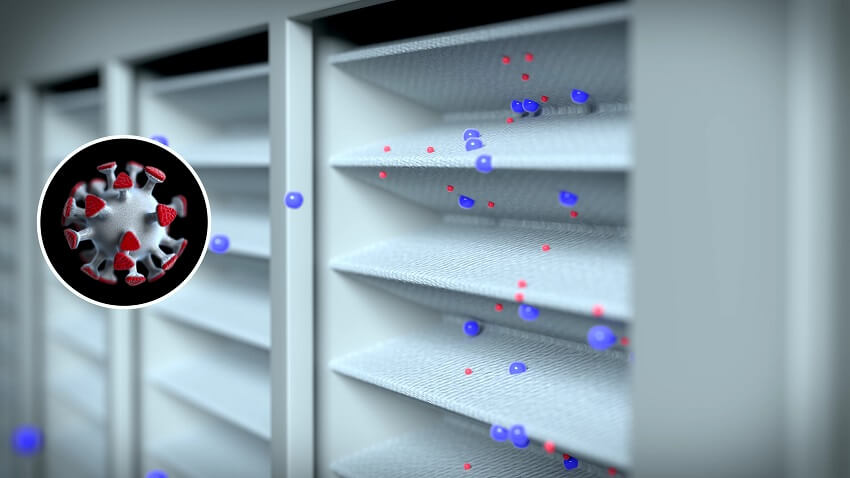
Irradiation
Ultraviolet (UV) light has been inactivating viruses and bacteria since the 1950s. UV-C, the shortest wavelength of the three forms of UV, is often found in medical facilities, and its use has expanded into other commercial ventilation. Most UV-C technology installs inside ductwork, next to coils, or near filters. Installation in protected spaces allows for the UV to render pathogens inert while posing no exposure risk to building occupants. UV-C is effective; however, it can be expensive to install, operate, and maintain, particularly in large buildings that require many UV-C subsystems.
Manufacturers continue to identify new uses for UV technology to improve IAQ. For example, Greenheck offers an integrated UV-C system with its HVLS fans. The UV-C lighting is installed near the tip of the fan blades and points upwards. The fan circulates large volumes of air over the blades, offering the perfect application for UV-C dosing. The combination of HVLS and UV-C provides a unique opportunity where you can achieve a large volume of air movement coupled with the benefits of UV-C but at lower upfront and operational costs.
Targeted High-Intensity Heat
High-intensity heat is another method to improve IAQ. This process requires heating air in the duct to a high temperature for a set time interval. The targeted, high-intensity heat inactivates viruses and bacteria provided the heat intensity and length of exposure are appropriate. For example, you can effectively inactivate viruses by heating air to a temperature of 158°F for approximately five minutes. Recent research indicates that 30 seconds might be enough time under certain conditions. Still, difficulties in managing a high-intensity heat system and its associated costs keep this technology from being used in many applications.
Air Purification
Air purifiers often combine several technologies to “clean the air”. Air purifiers normally include a fan and HEPA filter. Some purifiers also offer bipolar ionization, UV-C sterilization, or a combination of the two. While air purifiers can provide effective mitigation of airborne pathogens including COVID-19, flu, and cold viruses, they are recommended for use in conjunction with HVAC systems. Purifiers normally cover small areas, such as offices or cubicles. Larger purifiers are available and effective, but costly.
Air Filtration
Air filtration remains an extremely effective method for reducing the spread of airborne pathogens. A variety of filter options exist to serve a wide range of applications:
- Pleated – increased surface area while minimizing an airflow reduction
- Bag – generally used in multistep filtration and tends to have higher dust-holding capacity
- Cartridge – uses a rigid frame to provide greater durability and is reusable
- Washable – also called electrostatic filters are reusable, able to clean by washing, and are far more efficient than disposable filters
The ability to filter air effectively is based on its minimum efficiency reporting value (MERV). MERV-rated filters cover a broad spectrum of filtration capabilities. For example, residential furnace filters have a MERV rating between one and eight, and capture particles such as pollen, dust mites, and mold spores. However, these filters do little to capture the airborne pathogens that cause flu and COVID. A minimum MERV rating of 13 is required to capture these smaller particles. MERV 13 filters will capture slightly less than 75% of these small particles while a MERV rating of 17 or higher will collect up to 99.97% of airborne viruses. High-efficiency particulate air (HEPA) filters fall into this category. The higher-rated MERV filters are one of the most simple and effective ways you can protect occupants from airborne illnesses.
Still, filters are only one piece of your total ventilation solution. Not all ventilation equipment can accommodate filters with a higher MERV rating. All filters increase pressure drop and affect the overall efficiency of ventilation systems. For retrofits, it’s important to verify that the ventilation system can handle the increased system losses. New system designs must account for increased losses when utilizing these higher MERV-rated filters; this will increase the cost of the system as fan size, power consumption, or both will also increase.
Each of the technologies mentioned provides a level of protection against airborne pathogens. A ventilation system designed for optimal IAQ should include a combination of these options to protect against infection from COVID and other viruses.
However, few companies can afford the cost of implementing all of these solutions. If initial system cost, operational cost, and efficacy are your prime consideration, use filtration. MERV 13 and higher-rated filters capture most disease-carrying particles. The American Society of Heating, Refrigerating and Air-Conditioning Engineers (ASHRAE) recommends filters as an effective solution to lessen the infection rate of COVID and other airborne pathogens. The upfront cost of filtration is substantially less than irradiation, targeted high-intensity heating, or air purification. The use of filters can also reduce operational cost as they permit recirculation of clean air inside a building instead of necessitating tempering of outdoor air. Filtration is the only option that combines effective pathogen reduction with purchase and operation economics.
Indoor Air Quality
Read Next
Leverage Employee Comfort and Make it a Critical Part of Your Hiring Strategy
Three Tactics to Improve Indoor Air Quality (IAQ) in Schools and Commercial Buildings



from